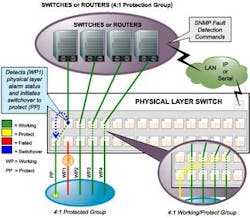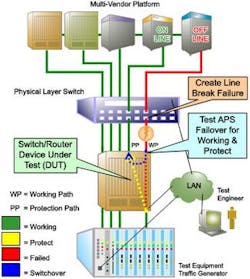Physical layer switches fill a gap for APS
The integration of a physical layer switch enables carriers to provide high availability services at a fraction of the cost of replacing or redesigning network elements.
Call it the desire to beat the competition; call it customers' unreasonable demand for 100% uptime of their voice and data service; or just call it the reality of doing business as a network-related manufacturer, carrier, or service provider. Whatever the case, the daunting drive toward network perfection has created the need for Automatic Production Switching (APS) to ensure a failsafe path for data to continue running even when network disruptions occur.
Equipment currently installed in switching fabric was designed before APS functionality was a priority, and re-engineering those switches is extremely difficult. Fortunately, there is a quick, low-cost solution to fill this gap between APS necessity and the lack of current APS functionality. A physical layer switch can add the extra ports needed to ensure high availability and can also facilitate lab testing by providing a variety of simulated network disruptions and replacing a previously manual process.
APS functionality is critical for today's carriers. Stringent service-level agreements between carriers and customers place a burden on the network provider to not only maintain system availability but to maintain a level of performance that reflects the critical nature of the application. Moreover, the demand for services around the clock in an increasingly complex, competitive, and unpredictable environment is driving the need for APS functionality in all areas of the network--from the core to the edge to the customer. Where once only the core or backbone of the network was the key area of focus for high availability, now switches that sit at the edge within the customer premise and even inside the Local Area Network (LAN) are expected to provide 100% uptime.
This shift in focus has switch providers designing next-generation equipment with APS features--and scrambling to find ways to provide APS functionality on legacy equipment. Since the majority of these switches sit at the customer premise or the edge of the network, the focus on high availability was never in demand until now. Customers want end-to-end protection, leaving carriers and switch manufacturers searching to find ways to provide it.
A key dilemma facing switch manufacturers attempting to design APS into legacy switches is the physical product structure. Chassis were never designed with expansion in mind, and line cards were designed to utilize existing ports for revenue generating services--not for sitting idly for protection services. Utilizing existing ports for APS only increases the overall cost of ownership to the network provider because they must take away revenue-generating interfaces currently in use. Switch vendors also do not want to put significant time and effort into redesigning older, end-of-life equipment because the return on investment yields very little reward.
On the carrier side, the current economy has forced them to tighten their belts considerably, and they do not want to undergo forklift upgrades to replace existing equipment with solutions that provide APS. They would rather spend money and time enhancing additional customer services and features that continue to generate new revenues.
Physical layer switches add extra ports
The function of an APS path is to provide a separate physical interface on the switch that is designated as a protection port. When a network disruption takes place, such as a line break or port failure, all data running on the failed interface is migrated to the protection port with no manual intervention, and network access is restored. A physical layer switch can provide an alternative to the APS.
Physical layer switches sit at locations between the physical cabling infrastructure entering a facility and where those cables terminate on network switching equipment. They are often used to replace manual patch panels that crossconnect wires in these locations. Physical layer switches provide the 1:N APS capabilities that both vendors and carriers are seeking. Using the open platform software capabilities built into physical layer switches like SNMP or other scripting capabilities to control the process, carriers are now creating solutions that provide one redundant circuit for many active circuits. If one active link breaks, a rollover to a protection link automatically takes place. Because physical layer switches do nothing to modify the data running on each interface, this alternative is non-intrusive, simple, and easy to manage.
When more advanced APS functionality is needed, switch vendors are embedding efforts in their switch software packages to communicate directly with a physical layer switch, enabling seamless control (see Figure 1).
Shortening time to marketing through automation
A layer-1 switch can also help reduce development costs and time-to-market for switch vendors designing new products with integrated APS functionality. Employing a physical layer switch within the test system enables engineers to automate many of the necessary test sequences.
Network switch manufacturers need the ability to break links and simulate various layer-1 network disruptions--whether the manufacturer is testing Asynchronous Transfer Mode (ATM) with Private Network-Network Interface (PNNI) or Internet Protocol (IP) with Open Shortest Path First (OSPF) or Routing Information Protocol (RIP)--to validate the re-route functionality these protocols produce without having to manually connect and reconnect the units. Physical layer switches provide manufactures an intelligent, automated method of testing APS functionality at individual interfaces (1:N) or between different line cards providing (1:1) APS redundancy built into the switch technology (see Figure 2).
Testing the APS functionality in a switch usually requires an engineer to plug and unplug cables from the back of a switch. While this usually works for simple forms of validation, it does not allow for repetitive testing that may be necessary over a period of time, nor does it give any clear validation to how the test was generated. Physical layer switches used in this environment allow engineers to repeat the same test over and over in set or timed intervals or to reproduce the same set of test sequences for regression testing over time. Test engineers can also simulate catastrophic network failures that are too complicated to simulate by manual effort.
Physical layer switches are playing a key role where carriers and carrier-class switch vendors once had a gap. The layer-1 switch can provide the extra ports needed to deliver high-availability services, as well as facilitating lab testing. The integration of a physical layer switch is a simple, cost-effective alternative to replacing or redesigning network elements.
Kevin Schaffer is product marketing manger for Apcon Inc., headquartered in Portland, OR. He may be reached via the company's web site at www.apcon.com.

